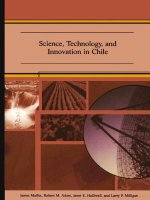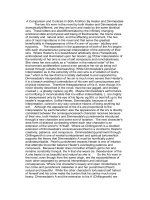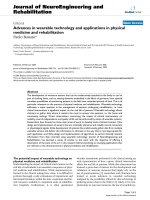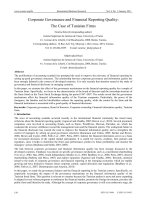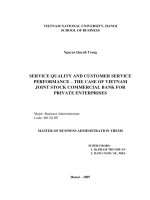- Trang chủ >>
- Y - Dược >>
- Sản phụ khoa
Technology and Inequalities in Education – A case of Massive Open Online Courses (MOOCs) in Distance Education in India as a means of Exclusion
Bạn đang xem bản rút gọn của tài liệu. Xem và tải ngay bản đầy đủ của tài liệu tại đây (266.89 KB, 8 trang )
<span class='text_page_counter'>(1)</span><div class='page_container' data-page=1>
<b>Working Paper </b>
<b>“Technology and Inequalities in Education – A case of Massive Open </b>
<b>Online Courses (MOOCs) in Distance Education in India as a means of </b>
<b>Exclusion” </b>
<b>By: Arunima Naithani </b>
Distance Education in India: Growth and Development
The Open and Distance Learning in India (or distance education) plays a significant role in
democratising the higher education system of the country. The growth and development of
distance education, as a sub-system of higher education in India has experienced several
stages. Beginning from pure correspondence courses in early 1960s, the range of educational
programmes, and institutional access has evolved and developed over time into
technology-enabled education system. Today, there are 14 State Open Universities, Indira Gandhi
National Open University –IGNOU, in addition over 40 Universities (Private, central, state)
which are dual mode institutions to provide distance education academic courses. In terms of
enrollment of students, distance education courses constituted 11.05 per cent of the total
gross enrollment ratio (GER) of 26 per cent in higher education, especially at the UG, PG,
and Certificate levels courses (AISHE Report, 2017-18). Impressively, the national open
university of India – IGNOU offers 232 academic programs and is the world's largest
university in terms of ever-growing enrolment (IGNOU Prospectus, 2017-18). This indicates
a progressive trend in distance education system in India as more than 3 million students are
enrolled in various distance-learning programmes offered by such institutes (Gaba & Li,
2015).
</div>
<span class='text_page_counter'>(2)</span><div class='page_container' data-page=2>
Although, higher education system in India is transforming rapidly to meet the global
demands of the 'networked society', but its GER (calculated for 18-23 years old) is not very
promising. Compared with other developed nations where the GER in Higher Education are
marked above 40 per cent, while in India it is still at 26 per cent. This presents a huge
challenge for the Government as the proposed target of 30% GER by 2020 is still unmet.
Since access to tertiary education, remains limited due to unavailability of „brick and mortar‟
institutions, educational resources and required faculty. Distance education seems one such
viable alternative through its flexible educational delivery and cost effectiveness in achieving
the larger objective of access and equity in the higher education realm. Particularly, in India
where hierarchies of castes, socio-economic status, gender relations and cultural diversities
deeply influence issues related to access and equity in affording quality education. In relation
to this, the Government strongly believes in the growth and development of distance
education system in India for an improved and sustainable knowledge society.
Education through Technology: Policy Initiatives
Technology is an indispensable part of everyday activities and it has its contribution on
educational processes as well, particularly in distance education mode. ICT enabled teaching,
and learning is one of the promising feature. Recent innovations have revolutionized the
system of distance education, particularly in forms of e-learning, blended learning, OER
(open educational resources). There is an emerging global educational community and India
is making huge progress to bring all possible latest developments to provide learners with
maximum learning opportunities. Moreover, the emergence of the Internet and the World
Wide Web has brought a radical shift in the transformation of education and training through
web based online courses to offer life-long learning opportunities.
</div>
<span class='text_page_counter'>(3)</span><div class='page_container' data-page=3>
been successful under the programme - NPTEL (National Programme on Technology
Enhanced Learning), a joint initiative of seven IITs and IISc institute funded by NMEICT
scheme. Launched in 2013, over time, it has developed around 933 courses in 23 disciplines
as e-learning programme to be provided through online Web and Video based courses in
engineering, science and humanities streams.
Therefore, the need to reach out to a large number of students and learners who are majorly
deprived of educational opportunities became a priority for the Government. At the beginning
of 2014, the MHRD, GoI undertook another initiative to develop a unified online learning
platform. A unified platform that would integrate several online Web and Video based
educational courses, already developed by subject experts from various educational institutes
under the NPTEL programme. With this objective and resource available, it was decided to
develop an indigenous platform for India‟s open online courses, thus a MOOC model was
designed called – SWAYAM.
SWAYAM –India’s MOOC
SWAYAM fully known as „Study Webs of Active Learning for Young Aspiring Minds‟
(SWAYAM) was launched as the beta version in 2017. A unique innovation featuring India‟s
“Digital India” initiative, aims to bring learners closer to the digitalized revolution society,
especially those who have remained untouched by the digital era. Developed under NMEICT
scheme, it supports the broader objective of providing access to quality education as well as
increase the GER in higher education in India.
</div>
<span class='text_page_counter'>(4)</span><div class='page_container' data-page=4>
through SWAYAM‟. This regulation is applicable to all public universities (even affiliated
institutes) as well as universities offering distance education courses. These educational
institutes shall allow their enrolled students to complete up to 20% of their degree online by
taking online courses on SWAYAM. These institutions would first have to earmark
SWAYAM courses as credit-eligible courses required for the academic term, and which upon
successful completion by the student will reflect in their degree.
At present there are more than 500 free online courses categorized as Engineering (137
courses), Science (93 courses), Business (58 courses), Social Sciences (44 courses),
Computer Science (36 courses), Humanities (31 courses), followed by Programming, Data
Science, Education, Mathematics, Health and Medicine. Moreover, Institutions such as the
IITs and IIMs, among others, have collaborated with SWAYAM initiative to offer around
2,000 courses in science and management (Chauhan, 2017). In addition, it has been reported
that around 2,300 courses on edX will soon be co-hosted on SWAYAM web portal for Indian
students (Goyal, 2018).
Indian Learners in Global MOOCs Platform
These latest web-based courses, particularly, MOOCs - open online courses that allow for
unlimited participation, as well as SPOCs (Small Private Online Courses), is said to have
revolutionized universities and the higher education landscape (Kaplan & Haenlein, 2016).
Availability of MOOCs has recently attracted a very large number of students. Since their
emergence in 2012, the number of registered MOOC users has significantly increased.
Currently, at the global level, about 800 universities offer 9,400 courses on MOOC platforms.
In addition to 81 million MOOC users globally in 2017, new 23 million learners are expected
to join in the following year (Class Central, 2018). This signifies the massiveness and open
aspects of MOOCs, that is, an online distance course accessible without entry requirements
by anyone at no cost, thus making it unique.
</div>
<span class='text_page_counter'>(5)</span><div class='page_container' data-page=5>
MOOC learners from India are one of the largest groups enrolling (after participants from the
United States and China).
All around the world leading universities have collaborated with MOOC providers such as
Coursera and EdX to deliver high-quality online courses free to millions of learners. These
two are currently the largest higher education provider in the world in terms of registered
learners in the virtual learning platform. With Indian students signing up for MOOCs,
globally in large numbers and embracing the online education learning models is an
interesting research inquiry. It is even predicted that in coming years the market for MOOCs
in India will be much bigger than the U.S (Anant Agarwal, CEO, edX, as cited in
Damodharan, 2016). The data echoes the demand for a massive market space for MOOCs for
the Indian learners, which has become a great alternative for the learners to access quality
higher education course content through online learning.
The Digital Divide and Criticism on MOOCs
This massification of MOOCs are under a lot of criticism and scrutiny. The large-scale
implementation of MOOCs in the international education market has not paid much attention
to the process of completion and engagement with the courses, as well as, the increasing
dropout rates (Liyanagunawardena et al., 2013; Jordan, 2015). Moreover, million learners in
the world today are still untouched by the empowering features of online learning and
MOOCs. This has provoked a lot of criticism towards the exclusivity factor of MOOCs and
the homogenous profile of learners. Since access to technology in any society is not uniform,
this further reinforces the existing educational divide in the digital world.
Globally, there is a wide disparity within people to make effective use of Information,
Communication and Technology (ICT) in their everyday lives. Mainly caused by the digital
divide, that is the gap between learners who have effective access to information technology,
and those who are left out without access and usage. As quoted by Paul (2002) - the phrase
“digital divide” refers to the unequal and disproportionate pace of development in societies in
having access to digital infrastructure and services (p. 13). The research in digital divide
broadly conceptualizes it in terms of the differences of accessibility to technology and user‟s
digital skills for usage. For the accessibility of high-quality content of MOOC courses, a
learner requires high-speed internet or wi-fi connectivity (for downloading material and
viewing videos), either on the desktop or mobile devices. This raises the issue of
technological cost for many in developing countries, especially relevant for rural and remote
township communities, thus leaving behind learners who are digitally disadvantaged.
</div>
<span class='text_page_counter'>(6)</span><div class='page_container' data-page=6>
subjective, economic, imaginary structurations of lived experience and the systems within
which we exist and operate” (pp. 368–369). Such robust understanding of digital divide has
to be acknowledged, to shift away from the technological determinist perspective and move
towards a framework that examines how the digital divide reflects and reinforces society‟s
social and economic inequities (Light, 2001; Mossberger et al., 2003). This digital divide,
which is a reproducer of larger social problem, is misunderstood even at the policy and
institutional level. Light (2001) critiques policies that concentrate on technical fixes for these
social problems, stating, „the digital divide debate is based on a technologically determinist
assumption that closing gaps in access to computers will mitigate broader inequalities – an
assumption requiring enormous faith in the capacity of a technology to bring about major
social change‟ (Ibid.).
Proponents of MOOCs, emphasize that MOOCs are recent innovations in the educational
domain, which makes education “class blind” (Agarwal, 2013), and “allow people who lack
access to world-class learning, an opportunity to make a better life for themselves and their
families” (Friedman, 2012). Therefore in a just and equitable society, the notion of
“class-blind” would refer to witnessing least affluent students equally or overrepresented in the
distribution of MOOC enrolled students, as well as, completing courses successfully. Instead,
earliest evidence of MOOC enrollment saw that most registered students/learners are from
privileged background (Ho et al., 2013; Perna et al., 2014). MOOC users are well, educated
young male learners aged under 30 (mostly post-secondary degrees and graduate degree).
Most of them are predominantly from developed and emerging countries (US, Europe, India,
China, UK) generally in job market belonging to a privileged and advantaged background in
terms of socio-economic status and technologically advancement (Glass et al., 2015). Similar
findings are reflected in the context of India, it was found that majority of Indian MOOC
students are employed full-time and using the courses to develop skills that help them at their
current job or will help them find a new one (Christensen et al., 2013). This highlights that
MOOCs are at a greater extent augmenting educational advantages to „educated‟ student
community than educating the „have-nots‟ or digitally disadvantaged students (Emanueal,
2013).
Digital inequality is one of the newer forms of inequalities, which is prominent in the society
along with the long-standing traditional forms of inequalities. It is mainly understood in the
broader context of social inequality and social stratification, seen as the different skills
required for using information sources and opportunities that are the major cause of digital
divides (Hargittai & Hinnant, 2008; Selwyn, 2004). Moreover, the existing patterns that
characterize and shape social structures, such as education, skills, income, occupation, and
gender strongly influences access to and use of the Internet (Rice & Katz, 2003; van Deursen
& van Dijk, 2013). Therefore, there exist a complex interplay between MOOC learner
educational status and existing educational inequality.
</div>
<span class='text_page_counter'>(7)</span><div class='page_container' data-page=7>
language that further perpetuate educational divides resulting in massive dropouts. DiMaggio
and Hargittai (2001) point out that there are at least five dimensions of digital inequality:
equipment, autonomy of use, skill, social support, and the purpose of using the Internet. Thus
understanding such patterns of MOOC enrolled students and those left behind is critical to
determining whether MOOCs are ameliorating or exacerbating educational inequalities
(Hansen & Reich, 2015).
In order to understand and address digital divides and educational inequalities, research in
MOOCs need exhaustive demographic information on student profile. The future research in
studying the digital divide thus should include „robust survey-based and in-depth qualitative
work which begins to unpack the complexities of the digital divide‟ (Selwyn, 2004).
Particularly, assessing registrants‟ socioeconomic status (SES), to understand “one‟s access
to financial, social, cultural, and human capital resources” (Hansen & Reich, 2015). Research
even suggests that MOOCs do not yet appear to be reaching the developing world and critical
target groups such as women, unemployed youth and digitally disadvantage learners. The
lack of utilization of MOOCs in developing and lower-income countries may be because
young learners are unaware of the benefits of MOOCs (Ibid.). Moreover, the mere access to
high-level MOOCs content does not manifest in effective learning or knowledge generation
in a specific course or topic. For MOOCs to be meaningful, they need to be supported with
continuous academic support, diagnostic assessment, feedback and peer engagement. This is
particularly necessary for students from academically disadvantaged contexts, and in
developing countries such as India, which have a glaring digital divide.
United Nations embraced the IT developments and technological changes in the early 21st
century as major markers for growth and development and acknowledged the usage of
Internet as a basic human right. However, various studies (Singh, 2010; Guillen, 2006;
DiMaggio et al., 2001) highlights that the problem of the digital divide is starker in the
developing countries such as in India. Research suggests there are several factors like
physical access, lack of ICT skills and support, attitudinal factors, age, gender, low literacy
rate, language barriers, geographical (rural-urban) which reinforce this digital divide
especially in India.
</div>
<span class='text_page_counter'>(8)</span><div class='page_container' data-page=8>
using mobile phones, which is far more extreme than the global divide as highlighted by
UNICEF report (2017).
Over the years, wireless connectivity has grown exponentially with over billion active
connections. Increased accessibility, availability of bandwidth, and affordable data costs have
brought some radical changes towards massive internet users from rural India. Recent studies
indicate (ICUBE 2018) that there are active internet users from rural India who are accessing
the internet to meet their entertainment and communication needs. However, the high-value
functions of mobile Internet penetration and 4G/3G services are still in nascent stages. Thus,
given the low penetration of the Internet, there is a possibility that access to the Internet is
present only among the privileged, digitally advantaged section of society from urban
pockets. Moreover, the current data on Internet usage from private agencies offer very little
insights on how various social groups are excluded from the digital space (Ilavarasan, 2013).
It is definite that India is facing similar challenges in offering MOOCs, especially with the
SWAYAM model. As highlighted by MOOCs critique in India, the development of MOOCs
might undervalue the public educational institutes, further reinforcing educational inequality,
especially for the specific segments of students/learners. What remains unnoticed is the
existing challenges, which persist in the present system of distance education, particularly,
for students who are enrolled in the conventional correspondence mode of learning. Teaching
practice in India and course curriculum particularly at distance mode is extremely
conservative. While, the syllabi of online courses differ from university courses, and the
level/speed of teaching is often too fast for students at regional colleges. Even if there are
plans and attempts to mix MOOCs with courses in other institutes, it may have limited
success. Understanding language and the accent is another serious concern since in India
MOOCs courses are being offered only in two languages – English and Hindi. As mentioned
earlier, the technical constraints in online learning such as network bandwidth that is, limited
video streaming and access other interactive content will dilute the chances for most of the
digitally disadvantaged students in India.
</div>
<!--links-->
